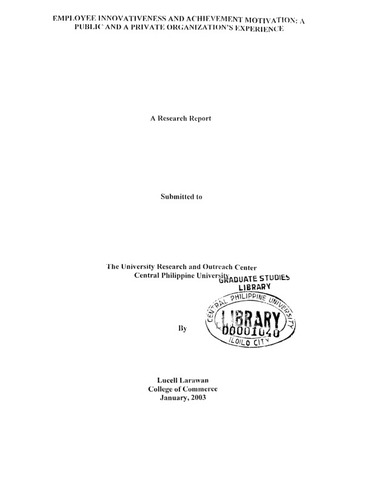Employee innovativeness and achievement motivation: A public and a private organization's experience
| dc.contributor.author | Larawan, Lucell A. | |
| dc.date.accessioned | 2021-05-20T07:27:57Z | |
| dc.date.available | 2021-05-20T07:27:57Z | |
| dc.date.issued | 2003-01 | |
| dc.identifier.citation | Larawan, L. A. (2003). Employee innovativeness and achievement motivation: a public and a private organization’s experience (Research report). Jaro, Iloilo City : University Research Center, Central Philippine University. | en_US |
| dc.identifier.uri | https://hdl.handle.net/20.500.12852/893 | |
| dc.description | Abstract only | en_US |
| dc.description.abstract | The study sought to determine and compare the level of innovativeness and achievement motivation of teachers from a public and a private college. It further aimed to correlate these main variables to the organizational orientation, age, type of institution and sex of respondents. The 122 full-time faculty members from the College of Arts and Sciences of CPU and WVSU were subjected to three tests: the level of innovativeness, achievement motivation and the organizational orientation tests. Two of the instruments used- the innovativeness and organizational orientation tests- were slightly modified validated questionnaires developed in the US. These were pretested and modified to fit the local scenario. The third instrument was a modified version of SERDEF's achievement motivation test that is catered to teachers. The data were gathered thru a one-shot survey. The data processing was made using SPSS version 11. The statistical analyses employed frequency distribution and mean for the descriptive part and Pearson’s r, Cramer’s V and t-test for the inferential part. The teachers were moderately innovative and had a high achievement motivation. Their organizations were described as “mixed” in orientation. Comparing the CPU and WVSU CAS teachers. The faculty members from both CPU and WVSU CAS were moderately innovative. Those from WVSU CAS worked in a formalized and relatively rigid or mechanistic organization, whereas, the faculty members in CPU CAS worked in a mixed organization. Teachers from both institutions had a high achievement motivation. Innovativeness level was significantly influenced by achievement motivation level possessed by the teachers and organizational orientation. However, it was not influenced by age, sex and type of institution. On the other hand, achievement motivation level could be explained by sex and age of respondents. The type of institution and organizational orientation had no bearing with the achievement motivation of the teachers. | en_US |
| dc.format.extent | iv, 45 leaves | en_US |
| dc.language.iso | en | en_US |
| dc.publisher | Central Philippine University | en_US |
| dc.subject.ddc | GSL 378.242 L321 | en_US |
| dc.subject.lcsh | Educational innovations | en_US |
| dc.subject.lcsh | Achievement motivation | en_US |
| dc.subject.lcsh | Employee motivation | en_US |
| dc.subject.lcsh | Universities and colleges--Employees | en_US |
| dc.subject.lcsh | Employees | en_US |
| dc.title | Employee innovativeness and achievement motivation: A public and a private organization's experience | en_US |
| dc.type | Technical Report | en_US |
| dcterms.accessRights | Limited public access | en_US |
| dc.description.bibliographicalreferences | Includes bibliographical references | en_US |
| local.subject | Central Philippine University (CPU). College of Arts and Sciences. | en_US |
| local.subject | West Visayas State University (WVSU) | en_US |
| local.subject | Innovativeness | en_US |
Fichier(s) constituant ce document
Ce document figure dans la(les) collection(s) suivante(s)
-
Research reports [167]
-
Research reports [17]


